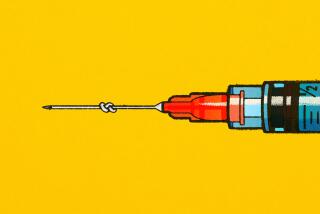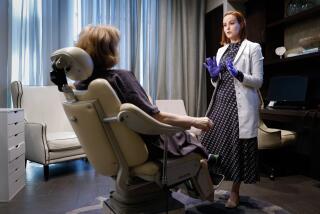Allergan Bets on Botox Lift
- Share via
Kimberly Horowitz is an international gem buyer specializing in diamonds, brokering deals in the hundreds of thousands of dollars. In her line of work, a confident, relaxed appearance can be the difference between negotiating a great price or merely a good one. That’s why she decided her crow’s feet had to go.
“Lines and furrows make you look tense or worried even when you’re not. In my job, I try to have a poker face,” said Horowitz, 41. The Sherman Oaks resident relies on injections of botulinum toxin type A, or Botox, to lose the lines without undergoing surgery.
“This is a wonderful tool. Your face looks very relaxed, like someone who has been on the beach for a week. That’s how it makes me feel,” Horowitz said.
That also makes her the kind of person whom Allergan Inc. hopes to attract in droves through a nationwide media blitz for its Botox Cosmetic. The Irvine company is positioning Botox as a simple, safe and affordable way to inhibit the signs of aging.
“Your toughest wrinkle,” it says in a print ad, with lines superimposed on a woman’s forehead. “It took 40 years to get it and 10 minutes to do something about it.”
But Allergan is banking on much more from Botox, which is the company’s biggest product, with worldwide sales of $310 million in 2001 and $88.6 million in the first quarter of 2002. Company executives are hoping that it will mitigate the potential loss of sales for its next-best-selling drug, glaucoma medication Alphagen, which is losing its battle in federal court against generic competition.
Taking Advantage of the Drug’s Versatility
Company executives also hope that Botox will fuel Allergan’s transformation into a specialty-pharmaceuticals-only business as they sell off its ophthalmic surgical devices and well-known contact-lens-care units. That makes Botox even more important to help fund research and development, and Allergan intends to milk it throughout the decade.
“You need to look at Botox as a series of waves. The first was movement disorders. The second is the cosmetic wave,” said Eric Brandt, Allergan’s chief executive. “The next wave is [use for] pain and headaches, in the 2006 time frame.”
Brandt said 2008-2009 could see the use of Botox on so-called smooth or involuntary muscles that function automatically, such as those of the intestines. He said it might be effective on a type of intestinal lesion whose healing requires the muscles to relax.
“Botox is very much a versatile and strategic product,” Brandt said. “It’s an excellent motor to drive the company forward for some of the earlier-stage technology we want to produce in the next three to five years.”
Analysts differ on the scope of Botox sales growth around the world, but most say Botox growth will be significant, with competing formulations and technological alternatives as much as three years distant. Cosmetic purposes account for about one-third of Botox sales, an Allergan spokeswoman said.
Allergan is hoping for a 25% to 35% increase in Botox sales for 2002, up to $385 million to $420 million, said Morningstar analyst Travis Pascavis.
“It’s realistic. That’s not a blockbuster by industry standards, but it is by Allergan standards and that would be very successful,” Pascavis said.
Corey Davis, an analyst for J.P. Morgan Chase & Co., said Botox “could hit $740 million in annual sales by 2005.”
Shares of Allergan fell 69 cents to $58.21 on the New York Stock Exchange on Wednesday.
Allergan is dwarfed by its biggest competitors in the pharmaceutical industry. It posted revenue of $1.7 billion in 2001, compared with $32.2 billion for Pfizer Inc., the nation’s biggest drug maker.
But Allergan executives say that this is an unfair and inaccurate comparison and that they are well-placed in the specialty pharmaceuticals market, which comprises smaller companies that typically do not engage in their own research and development, as Allergan does. Such companies can afford to promote products that sell in the low hundreds of millions of dollars and below, a level the giants can’t justify.
Botox has been around for years, purified and used in small amounts from the same bacterium that causes botulism, a rare but sometimes fatal paralytic illness. Botox was originally approved in the U.S. and several other countries for neuromuscular treatment of strabismus, or crossed eyes; for blepharospasm, an uncontrollable blinking of the eyes that renders a victim clinically blind; and for cervical dystonia, uncontrollable neck spasms.
Even though the Food and Drug Administration had not approved other uses of Botox in the U.S., doctors still were permitted to prescribe it for off-label purposes such as cosmetic improvements. It does not remove wrinkles or creases, doctors say, but stops the muscle contractions that create them. A treatment usually lasts three to four months.
Allergan is riding the FDA’s recent and first approval of Botox use for cosmetic purposes in treating a specific kind of wrinkle: the vertical lines that can develop just above the nose and between the eyebrows. That is significant because Allergan now can advertise Botox for that purpose.
“This is really closer to selling makeup than selling a drug that treats cancer or AIDS or other types of serious illness,” said Terri Seligman, an attorney with the law firm Loeb & Loeb who reviews ads for clients to make sure they won’t be sued for making unrealistic claims or false statements about competitors. “This is appealing to a person’s vanity.”
Botox is not without its critics. They seize on information from doctors that Botox, once a rather exclusive option of the wealthy and successful actors and actresses, now is being used by younger and younger Americans at the faintest hint of a wrinkle.
Allergan, these detractors say, is just adding to the nonstop mix of advertisements that bludgeon consumers with a unhealthy image of women who are too skinny, too artificial and too willing to portray age as something that must be hidden at all costs.
How Far Will a Woman Go for Beauty?
Botox is “not a simple extension of cosmetics. Parts of your face are paralyzed for several months,” said Manon Slome, a feminist museum curator who is about to open a three-month art exhibit at the Jewish Community Center in Manhattan called “Dangerous Beauty,” which is critical of “ageist and sexist images of beauty that products such as Botox perpetuate.”
Debbie Ramos of Whittier has refused invitations to join Botox parties, where customers can get a cut rate from a doctor by bringing in lots of business.
Ramos, 40, said some women have received Botox injections above the nose, across the forehead and around the eyes for crow’s feet “all at once. They look totally dead because they can’t change their expressions. People are out of control.
“Maybe they should use Preparation H instead,” Ramos said. “It eases the swelling, takes out wrinkles and it’s a good moisturizer too.”
Worldwide sales of Botox, which have increased more than twelvefold since 1993, suggest that these critics are a distinct minority.
Dr. Ted Daly averages about six Botox patients a week and says that he isn’t bothered that those numbers will grow because of Allergan’s ad campaign. Daly has a private practice in Garden City, N.Y., and is director of pediatric dermatology at Long Island’s Nassau University Medical Center.
“If I think they don’t need it, I’m going to tell them they don’t need it,” Daly said, adding that the procedures usually cost patients $300 to $600.
“People are pretty much uniformly satisfied.”
More to Read
Inside the business of entertainment
The Wide Shot brings you news, analysis and insights on everything from streaming wars to production — and what it all means for the future.
You may occasionally receive promotional content from the Los Angeles Times.











